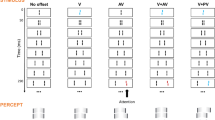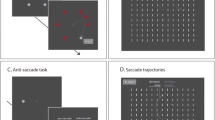Abstract
In dynamic sensory environments, successive stimuli may be combined perceptually and represented as a single, comprehensive event by means of temporal integration. Such perceptual segmentation across time is intuitively plausible. However, the possible costs and benefits of temporal integration in perception remain underspecified. In the present study pupil dilation was analyzed as a measure of mental effort. Observers viewed either one or two successive targets amidst distractors in rapid serial visual presentation, which they were asked to identify. Pupil dilation was examined dependent on participants’ report: dilation associated with the report of a single target, of two targets, and of an integrated percept consisting of the features of both targets. There was a clear distinction between dilation observed for single-target reports and integrations on the one side, and two-target reports on the other. Regardless of report order, two-target reports produced increased pupil dilation, reflecting increased mental effort. The results thus suggested that temporal integration reduces mental effort and may thereby facilitate perceptual processing.


Similar content being viewed by others
References
Akyürek, E. G., Eshuis, S. A. H., Nieuwenstein, M. R., Saija, J. D., Başkent, D., & Hommel, B. (2012). Temporal target integration underlies performance at Lag 1 in the attentional blink. Journal of Experimental Psychology. Human Perception and Performance, 38, 1448–1464.
Akyürek, E. G., & Meijerink, S. K. (2012). The deployment of visual attention during temporal integration: An electrophysiological investigation. Psychophysiology, 49, 885–898.
Akyürek, E. G., Schubö, A., & Hommel, B. (2010). Fast temporal event integration in the visual domain demonstrated by event-related potentials. Psychophysiology, 47, 512–522.
Akyürek, E. G., Toffanin, P., & Hommel, B. (2008). Adaptive control of event integration. Journal of Experimental Psychology. Human Perception and Performance, 34, 569–577.
Allport, D. A. (1968). Phenomenal simultaneity and the perceptual moment hypothesis. British Journal of Psychology, 59, 395–406.
Bates, D., Maechler, M., Bolker, B., & Walker, S. (2013). lme4: Linear mixed-effects models using Eigen and S4. (R package version 1.0-5) [Computer Software]. Retrieved from http://CRAN.R-project.org/package=lme4
Beatty, J. (1982). Task-evoked pupillary responses, processing load, and the structure of processing resources. Psychological Bulletin, 91, 276–292.
Broadbent, D. E., & Broadbent, M. H. (1987). From detection to identification: Response to multiple targets in rapid serial visual presentation. Perception and Psychophysics, 42, 105–113.
Di Lollo, V., & Dixon, P. (1988). Two forms of persistence in visual information processing. Journal of Experimental Psychology. Human Perception and Performance, 14, 671–681.
Di Lollo, V., & Hogben, J. H. (1987). Suppression of visible persistence as a function of spatial separation between inducing stimuli. Perception and Psychophysics, 41, 345–354.
Dux, P. E., Wyble, B., Jolicœur, P., & Dell’Acqua, R. (2014). On the costs of lag-1 sparing. Journal of Experimental Psychology. Human Perception and Performance, 40, 416–428.
Efron, R. (1967). The duration of the present. Annals of the New York Academy of Sciences, 138, 713–729.
Eimer, M. (1996). The N2pc component as an indicator of attentional selectivity. Electroencephalography and Clinical Neurophysiology, 99, 225–234.
Eriksen, C. W., & Collins, J. F. (1967). Some temporal characteristics of visual pattern perception. Journal of Experimental Psychology, 74, 476–484.
Forget, J., Buiatti, M., & Dehaene, S. (2010). Temporal integration in visual word recognition. Journal of Cognitive Neuroscience, 22, 1054–1068.
Geerligs, L., & Akyürek, E. G. (2012). Temporal integration depends on increased prestimulus beta band power. Psychophysiology, 49, 1464–1467.
Hecht, S., & Verrijp, C. D. (1933). Intermittent stimulation by light: III. The relation between intensity and critical fusion frequency for different retinal locations. The Journal of General Physiology, 17, 251–268.
Hess, E. H., & Polt, J. M. (1964). Pupil size in relation to mental activity during simple problem-solving. Science, 143, 1190–1192.
Hogben, J. H., & Di Lollo, V. (1974). Perceptual integration and perceptual segregation of brief visual stimuli. Vision Research, 14, 1059–1069.
Hommel, B., & Akyürek, E. G. (2005). Lag 1 sparing in the attentional blink: Benefits and costs of integrating two events into a single episode. Quarterly Journal of Experimental Psychology, 58A, 1415–1433.
Kiss, M., van Velzen, J., & Eimer, M. (2008). The N2pc component and its links to attention shifts and spatially selective visual processing. Psychophysiology, 45, 240–249.
Long, G. M., & Beaton, R. J. (1982). The case for peripheral persistence: Effects of target and background luminance on a partial-report task. Journal of Experimental Psychology. Human Perception and Performance, 8, 383–391.
Miller, G. A. (1956). The magical number 7, plus or minus 2 – some limits on our capacity for processing information. Psychological Review, 63, 81–97.
Morey, R. D., & Rouder, J. N. (2013). Package BayesFactor, version 0.9.5. http://bayesfactorpcl.r-forge.r-project.org/
Olivers, C. N. L., Hilkenmeier, F., & Scharlau, I. (2011). Prior entry explains order reversals in the attentional blink. Attention, Perception, & Psychophysics, 73, 53–67.
Porter, G., Troscianko, T., & Gilchrist, I. (2007). Effort during visual search and counting: Insights from pupillometry. Quarterly Journal of Experimental Psychology, 60, 211–229.
Potter, M. C., Chun, M. M., Banks, B. S., & Muckenhoupt, M. (1998). Two attentional deficits in serial target search: The visual attentional blink and an amodal task-switch deficit. Journal of Experimental Psychology: Learning, Memory, and Cognition, 24, 979–992.
Potter, M. C., Staub, A., & O’Connor, D. H. (2002). The time course of competition for attention: Attention is initially labile. Journal of Experimental Psychology. Human Perception and Performance, 28, 1149–1162.
Privitera, C. M., Renninger, L. W., Carney, T., Klein, S., & Aguilar, M. (2010). Pupil dilation during visual target detection. Journal of Vision, 10, 1–14.
Raymond, J. E., Shapiro, K. L., & Arnell, K. M. (1992). Temporary suppression of visual processing in an RSVP task: An attentional blink? Journal of Experimental Psychology. Human Perception and Performance, 18, 849–860.
Rouder, J. N., Morey, R. D., Speckman, P. L., & Province, J. M. (2012). Default Bayes factors for ANOVA designs. Journal of Mathematical Psychology, 56, 357–374.
Rousselet, G. A., Macé, M. J. M., & Fabre-Thorpe, M. (2003). Is it an animal? Is it a human face? Fast processing in upright and inverted natural scenes. Journal of Vision, 3, 440–455.
Saija, J. D., Andringa, T. C., Başkent, D., & Akyürek, E. G. (2014). Temporal integration of consecutive tones into synthetic vowels demonstrates perceptual assembly in audition. Journal of Experimental Psychology. Human Perception and Performance, 40, 857–869.
Tervaniemi, M., Saarinen, J., Paavilainen, P., Danilova, N., & Näätänen, R. (1994). Temporal integration of auditory information in sensory memory as reflected by the mismatch negativity. Biological Psychology, 38, 157–167.
Van Rijn, H., Dalenberg, J. R., Borst, J. P., & Sprenger, S. A. (2012). Pupil Dilation Co-Varies with Memory Strength of Individual Traces in a Delayed Response Paired-Associate Task. PLoS One, 7(12), e51134.
VanRullen, R., & Thorpe, S. J. (2001). Is it a bird? Is it a plane? Ultra-rapid visual categorization of natural and artifactual objects. Perception, 30, 655–668.
Visser, T. A. W., Bischof, W. F., & Di Lollo, V. (1999). Attentional switching in spatial and non-spatial domains: Evidence from the attentional blink. Psychological Bulletin, 125, 458–469.
Visser, T. A. W., & Enns, J. T. (2001). The role of attention in temporal integration. Perception, 30, 135–145.
Wierda, S. M., Van Rijn, H., Taatgen, N. A., & Martens, S. (2012). Pupil dilation deconvolution reveals the dynamics of attention at high temporal resolution. Proceedings of the National Academy of Sciences U.S.A, 109, 8456–8460.
Zylberberg, A., Olivia, M., & Sigman, M. (2012). Pupil dilation: A fingerprint of temporal selection during the “Attentional Blink”. Frontiers in Psychology, 3, 1–6.
Acknowledgments
The authors thank Sarah Maass and Johanna Kuhr for assistance with data acquisition and Udo Böhm for discussions.
Author information
Authors and Affiliations
Corresponding author
Additional information
E. G. Akyürek and H. van Rijn shared senior authors.
Rights and permissions
About this article
Cite this article
Wolff, M.J., Scholz, S., Akyürek, E.G. et al. Two visual targets for the price of one? Pupil dilation shows reduced mental effort through temporal integration. Psychon Bull Rev 22, 251–257 (2015). https://doi.org/10.3758/s13423-014-0667-5
Published:
Issue Date:
DOI: https://doi.org/10.3758/s13423-014-0667-5




